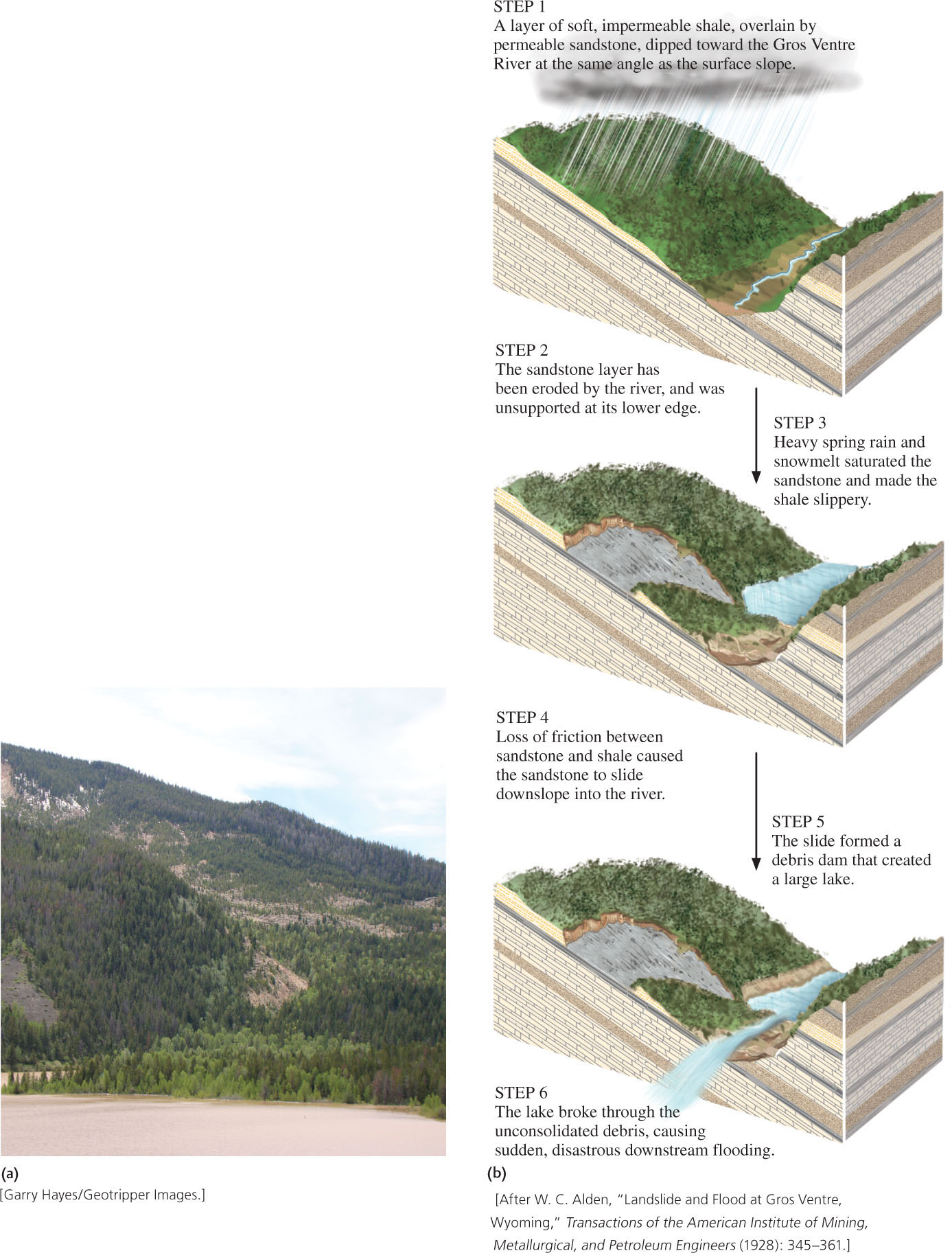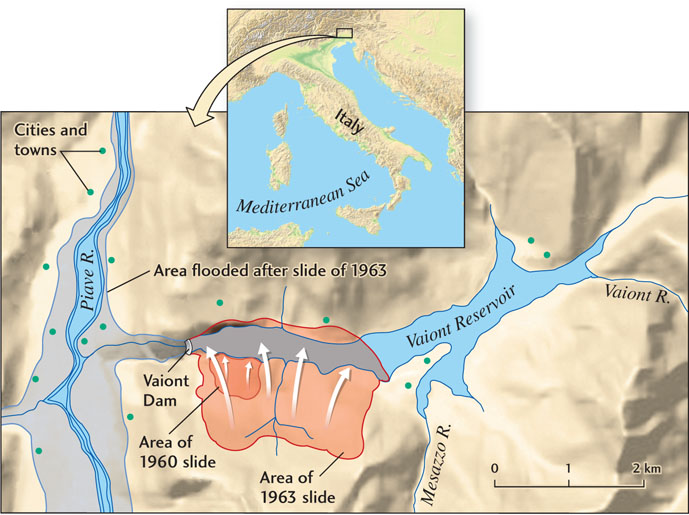Understanding the Origins of Mass Movements
To understand how slope steepness, the nature of the slope materials, and their water content interact to create mass movements, geologists study both natural mass movements and those provoked by human activities. They investigate the causes of a recent mass movement by combining eyewitness reports with geologic studies of the distribution and nature of the moved material as well as its source. They can infer the causes of a prehistoric mass movement from geologic evidence alone where the material is still present and can be analyzed for size, shape, and composition.
461
Natural Causes of Mass Movements
The 1925 landslide in the Gros Ventre River valley of western Wyoming illustrates how water, the nature of slope materials, and slope steepness interact to produce mass movements (Figure 16.28). In the spring of that year, melting snow and heavy rains swelled streams and saturated the ground in the valley. One local rancher, out on horseback, looked up to see the whole side of the valley racing toward his ranch. From the gate to his property, he watched the slide hurtle past him at about 80 km/hour and bury everything he owned.

(b) How the slide occurred.
About 37 million cubic meters of rock and soil slid down one side of the valley that day, then surged more than 30 m up the opposite side and fell back to the valley floor. Most of the rockslide was a confused mass of blocks of sandstone, shale, and soil, but one large section of the side of the valley, covered with soil and a forest of pine, slid down as a unit. The rockslide dammed the river, and a large lake grew over the next 2 years. Then the lake overflowed, breaking the dam and rapidly flooding the valley below.
The causes of the Gros Ventre slide were all natural. In fact, the stratigraphy and structure of the valley made a slide almost inevitable. On the side of the valley where the slide occurred, a permeable, erosion-resistant sandstone formation dipped about 208 toward the river, paralleling the slope of the valley wall. Under the sandstone were beds of soft, impermeable shale that became slippery when wet. The conditions became ideal for a slide when the river channel cut through most of the sandstone at the bottom of the valley wall and left it with virtually no support. Only friction along the bedding plane between the shale and the sandstone kept the layer of sandstone from sliding. The river’s undercutting of the sandstone’s support was equivalent to scooping sand from the base of a sand pile: both cause oversteepening. The heavy rains and meltwater saturated the sandstone and the surface of the underlying shale, creating a slippery surface along the bedding planes at the top of the shale. No one knows what triggered the Gros Ventre slide, but at some point shear stress at the base of the slide mass exceeded the shear strength, and almost all of the sandstone slid downslope along the water-lubricated surface of the shale.
462
The formation of a dam in a stream and the growth of a lake are common consequences of a mass movement. Because most slide materials are permeable and weak, such a dam is soon breached when the lake water reaches a high level or overflows. Then the lake drains suddenly, releasing a catastrophic torrent of water (see Figure 16.28).
Human Activities That Promote or Trigger Mass Movements
Although the vast majority of mass wasting is natural, human activities can trigger landslides or make them more likely in vulnerable areas. Construction and excavation activities that result in the steepening or undercutting of slopes, and activities such as clear-cutting that remove vegetation cover, can increase the likelihood of landslides. Careful engineering of drainage systems in vulnerable areas can keep water from making slope materials more unstable. Some geologic settings are so susceptible to landslides, however, that we should forgo construction projects in these areas entirely.
One such place was Vaiont, a valley in the Italian Alps bordered by steep walls of interbedded limestone and shale. A large reservoir had been formed in the valley by a concrete dam (the second highest in the world at the time, at 265 m). On the night of October 9, 1963, a great debris slide of 240 million cubic meters (2 km long, 1.6 km wide, and more than 150 m thick) plunged into the deep water of the reservoir. The debris filled the reservoir for a distance of 2 km upstream of the dam and created a giant spillover. In the violent torrent that hurtled downstream as a 70-m-high flood wave, 3000 people died.
Engineers had ignored three warning signs at Vaiont (Figure 16.29):
- 1. The weakness of the cracked and deformed layers of limestone and shale that made up the steep walls of the reservoir
- 2. The scar of an ancient slide on the valley walls above the reservoir
- 3. A forewarning of danger signaled by a small rockslide in 1960, just 3 years earlier

Although the 1963 landslide was natural and could not have been prevented, its consequences could have been much less severe. If the reservoir had been located in a geologically safer place, where the water was less likely to spill over the dam, damage might have been limited to a lesser loss of property and far fewer deaths. We cannot prevent most natural mass movements, but we can minimize our losses through more careful planning of construction and land development.
463